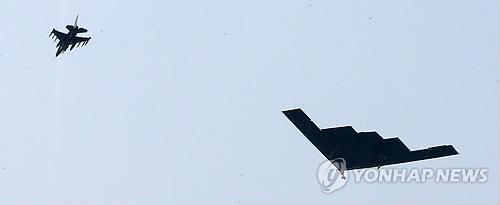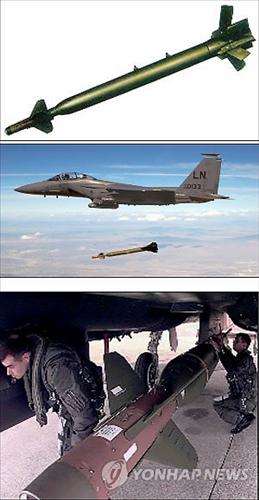U.S. B-2 stealth bomber conducts first firing drill in Korea
By Kim Eun-jung
2013/03/28 16:59 KST
SEOUL, March 28 (Yonhap) The United States air force's nuclear-capable B-2 stealth bombers carried out its first-ever firing drill over the Korean Peninsula on Thursday, the Combined Forces Command said, sending another strong warning to North Korea, which has threatened a preemptive nuclear attack on the U.S. and South Korea.
The U.S. Strategic Command sent two B-2 Spirit Bombers for "a long-duration, round-trip training mission" from Whiteman Air Force Base in the U.S. state of Missouri to South Korea in a demonstration of the country's defense of South Korea and to provide "extended deterrence to its allies in the Asia-Pacific region," the CFC said in a release.
The drill was part of the ongoing bilateral Foal Eagle training exercise, which began on March 1 and will run through April 30, to test the combat readiness of the allies.
The B-2 stealth bombers' mission involves dropping munitions and then returning to its base in a single, continuous flight ranging over 6,500 miles, the CFC said.
"The United States is steadfast in its alliance commitment to the defense of the Republic of Korea, to deterring aggression, and to ensuring peace and stability in the region," the CFC said in a release. "The B-2 bomber is an important element of America's enduring and robust extended deterrence capability in the Asia-Pacific region."
 |
The latest move comes after North Korea's military earlier this week put its strategic rocket units on combat ready status, with a fresh threat to strike targets in South Korea as well as the U.S. mainland, Hawaii and Guam.
The bomber, built by U.S. aerospace firm Northrop Grumman, has a crew of two and can drop up to 230-class Joint Direct Attack Ammunition (JDAM) GPS-guided bombs.
"As the B-2 has radar-evading stealth function, it can penetrate the anti-aircraft defense to drop conventional and nuclear weapons," a senior military official said. "It is the strategic weapon most feared by North Korea."
It is not the first time the U.S. military has unveiled its nuclear-capable weapons deployed from overseas bases to the peninsula during this year's joint exercises. Also taking part from the U.S. were U.S. B-22 bombers and a nuclear submarine USS Cheyenne (SSN 773), both of which are capable of deploying nuclear weapons.
The latest move comes after U.S. Deputy Defense Secretary Ashton Carter promised to provide all possible resources to provide extended nuclear deterrence on the peninsula during his visit to Seoul earlier this month.
The U.S. nuclear triad is composed of heavy bombers, intercontinental-range ballistic missiles, and submarine-launched ballistic missiles.
Under a new joint operational plan recently signed between the two allies, the South Korean military can ask the U.S. forces to provide reinforcements from within and outside of South Korea, including Japan and elsewhere in the region under the control of the U.S. Pacific Command, if North Korean provocations escalate.
According to a South Korean military official, the U.S. government has recently approved sales of Guided Bomb Unit-28, the so-called "bunker buster," which is designed to hit targets buried deep underground, such as North Korea's underground nuclear and missile facilities. It would cost about 70 billion won (US$62.8 million) to buy about 200 bunker buster bombs.
"The U.S. government approved sales of GBU-28 to South Korea," the official said, asking for anonymity. "South Korea plans to adopt them in May to deploy them by the end of this year."
Seoul has asked Washington to sell its 2,250kg-class bunker buster bombs to destroy North Korea's major military installations, such as nuclear and missile facilities, in the early stages of a potential war, but the decision has been delayed.
The latest approval underscores the U.S. commitment to helping raise the South Korean military's capability to cope with rising threats from the North's weapons of mass destruction and nuclear program in light of its third atomic test.
The bombs, which have a hardened-steel casing and can reach targets buried deep underground before exploding, can be dropped by fighter jets, such as the F-15K.
The bomber, built by U.S. aerospace firm Northrop Grumman, has a crew of two and can drop up to 230-class Joint Direct Attack Ammunition (JDAM) GPS-guided bombs.
"As the B-2 has radar-evading stealth function, it can penetrate the anti-aircraft defense to drop conventional and nuclear weapons," a senior military official said. "It is the strategic weapon most feared by North Korea."
It is not the first time the U.S. military has unveiled its nuclear-capable weapons deployed from overseas bases to the peninsula during this year's joint exercises. Also taking part from the U.S. were U.S. B-22 bombers and a nuclear submarine USS Cheyenne (SSN 773), both of which are capable of deploying nuclear weapons.
The latest move comes after U.S. Deputy Defense Secretary Ashton Carter promised to provide all possible resources to provide extended nuclear deterrence on the peninsula during his visit to Seoul earlier this month.
The U.S. nuclear triad is composed of heavy bombers, intercontinental-range ballistic missiles, and submarine-launched ballistic missiles.
Under a new joint operational plan recently signed between the two allies, the South Korean military can ask the U.S. forces to provide reinforcements from within and outside of South Korea, including Japan and elsewhere in the region under the control of the U.S. Pacific Command, if North Korean provocations escalate.
According to a South Korean military official, the U.S. government has recently approved sales of Guided Bomb Unit-28, the so-called "bunker buster," which is designed to hit targets buried deep underground, such as North Korea's underground nuclear and missile facilities. It would cost about 70 billion won (US$62.8 million) to buy about 200 bunker buster bombs.
"The U.S. government approved sales of GBU-28 to South Korea," the official said, asking for anonymity. "South Korea plans to adopt them in May to deploy them by the end of this year."
Seoul has asked Washington to sell its 2,250kg-class bunker buster bombs to destroy North Korea's major military installations, such as nuclear and missile facilities, in the early stages of a potential war, but the decision has been delayed.
The latest approval underscores the U.S. commitment to helping raise the South Korean military's capability to cope with rising threats from the North's weapons of mass destruction and nuclear program in light of its third atomic test.
The bombs, which have a hardened-steel casing and can reach targets buried deep underground before exploding, can be dropped by fighter jets, such as the F-15K.

A bunker buster bomb has a hardened-steel casing and can reach targets buried deep underground before exploding. It can be dropped by fighter jets, such as the F-15K. (Yonhap)
About 28,500 American forces are stationed in South Korea as the 1950-53 Korean War ended in a truce, not a peace treaty.
Source: english.yonhapnews.co.kr
oldmarine
'Yonhap' 카테고리의 다른 글
| N. Korea warns S. Korea of final action against Kaesong park (0) | 2013.04.29 |
|---|---|
| 北, 미사일 '은닉·전개' 반복…"피로감 극대화 전략" (0) | 2013.04.11 |
| '우리민족끼리' 가입 1만5천여명 실명확인 작업 착수 (0) | 2013.04.07 |
| (News Focus) Chinese tourists emerge as big spenders in S. Korea (0) | 2013.03.10 |
| <朴당선인 靑인선 '친정체제' 구축 신호탄> (0) | 2013.02.18 |